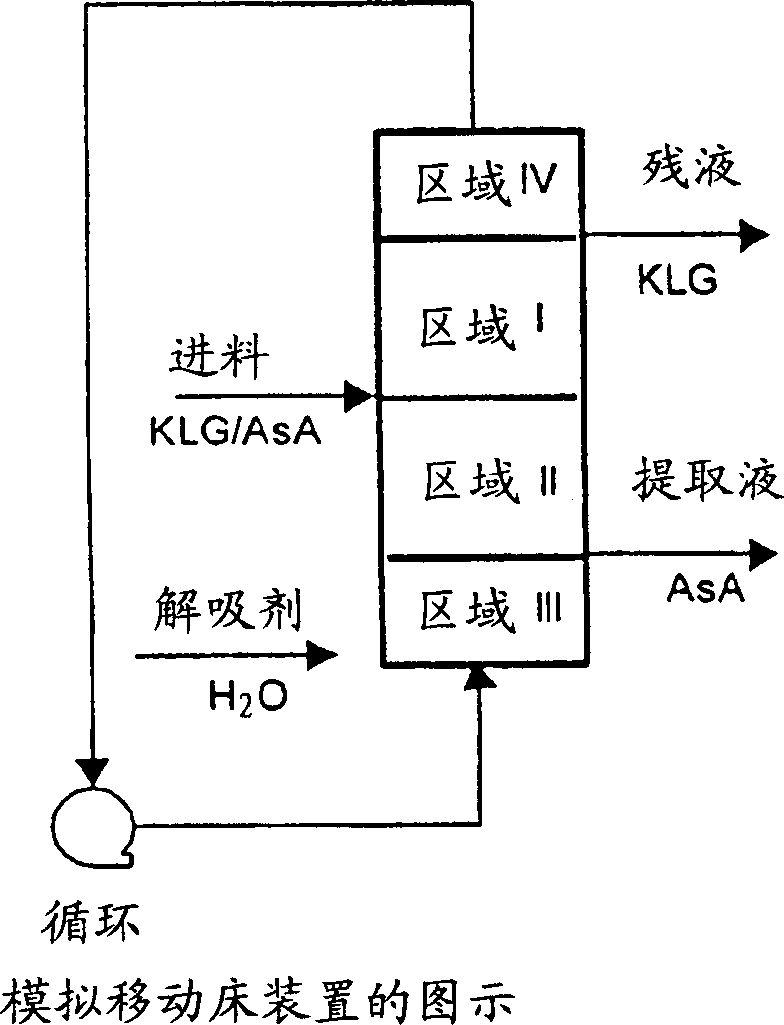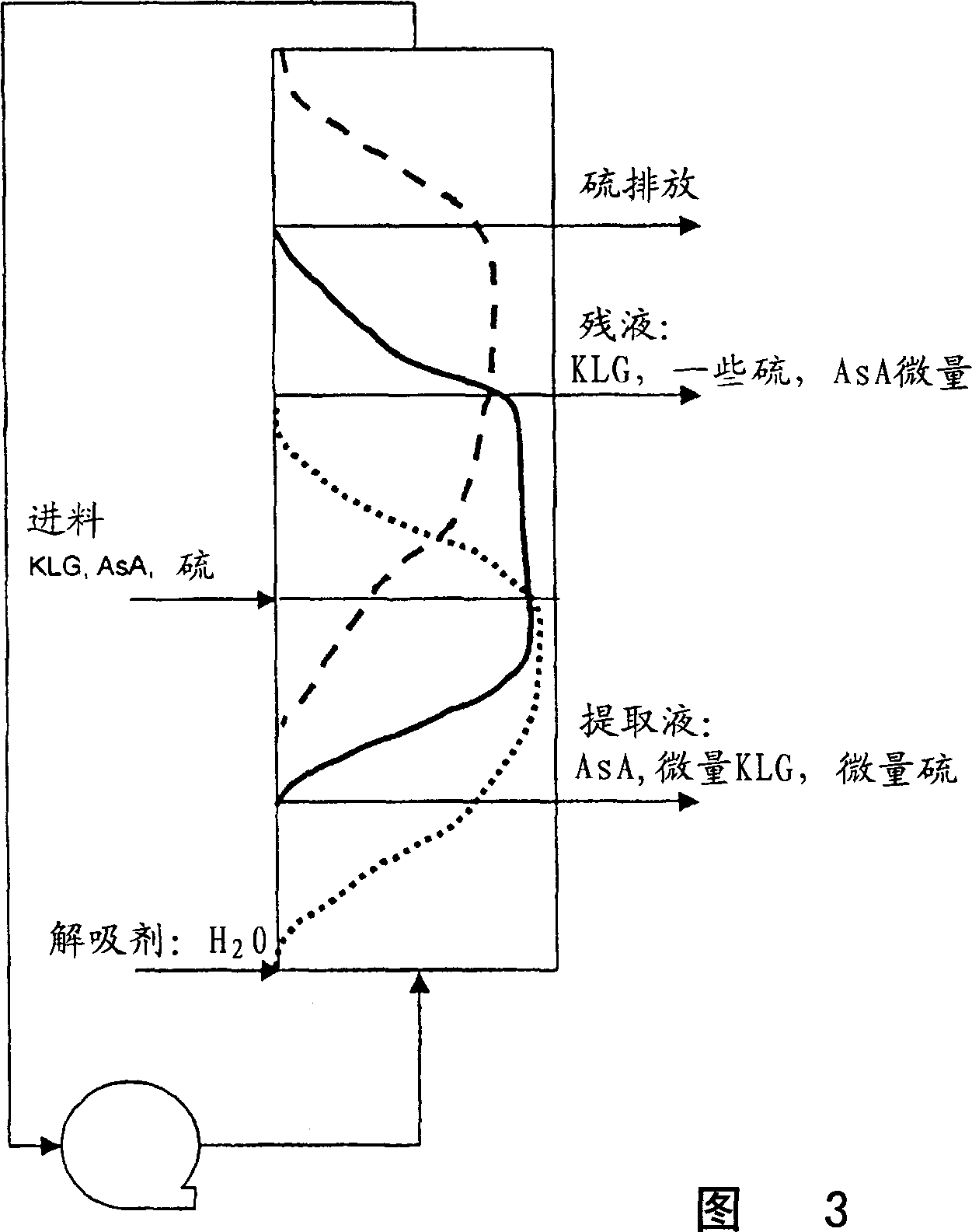Process for producing ascorbic acid in presence of sulfit
A technology of ascorbic acid and sulfite, applied in the direction of organic chemistry method, organic chemistry, chemical recycling, etc., can solve the problems of high carbon and unrealistic
- Summary
- Abstract
- Description
- Claims
- Application Information
AI Technical Summary
Problems solved by technology
Method used
Image
Examples
Embodiment 1
[0107] Examples 1-3: Examples 1-3 (Table 1) illustrate the effect of bisulfite additive concentration on the conversion of 2-keto-L-gulonic acid to ascorbic acid and the selectivity of the reaction. In Example 1, four samples were heated at 120°C for 2 hours, and each sample contained a 10 wt% solution of 2-keto-L-gulonic acid (based on anhydride) without any sulfite, on ice After cooling in a bath, analysis of 2-keto-L-gulonic acid and ascorbic acid was performed by high performance liquid chromatography (HPLC). In Examples 2 and 3, four sodium bisulfite (NaHSO 3 ) or 0.13wt% sodium bisulfite (NaHSO 3 ) in a 10 wt% solution of 2-keto-L-gulonic acid (anhydride based) was treated as described in Example 1. The average percent conversion of 2-keto-L-gulonic acid and percent selectivity to ascorbic acid for the four samples used in each example were calculated and listed in Table 1. It can be seen that increasing sulfite does not decrease selectivity, and in fact increases sel...
Embodiment
[0118] Example (min) (°C) (wt%) relative to KLG conversion selectivity increase) (% increase)
[0119] 9 7.5 120 5 0 42.81 77.85 0.1392 93.2
[0120] 10 7.5 120 5 30 48.57 85.61 0.0346 76.1
[0121] 11 7.5 120 10 15 53.73 76.3 01752 88.1
[0122] 12 7.5 120 15 0 55.05 71.07 0.0791 95
[0123] 13 7.5 120 15 30 61.83 73.58 0.3878 92
[0124] 14 3.5 150 5 15 36.65 84.23 0.0235 69
[0125] 15 3.5 150 10 0 41.72 78.26 0.2192 89.9
[0126] 16 3.5 150 10 15 45.62 79.37 0.0791 77.5
[0127] 17 3.5 150 10 30 46.25 82 0.0660 75.5
[0128] 18 3.5 150 15 15 46.3 75.23 0.1584 81.1
[0129] 19 2.3 180 5 0 39.56 83.73 0.1075 91.9
[0130] 20 2.3 180 5 30 51.71 80.84 0 0324 74.6
[0131] 21 2.3 180 10 15 49.04 75.87 0.1161 83.5
[0132] 22 2.3 180 15 0 45.83 72.38 0.5240 93.9
[0133] 23 2.3 180 15 30 47.05 73.1 0.0607 63.7
Embodiment 9-23
[0134] Examples 9-23: Examples 9-23 illustrate the percent selectivity and solution color of the concentration of sulfurous acid for the conversion of 2-keto-L-gulonic acid to ascorbic acid relative to the Reference Example in which no sulfurous acid was added. influences. The reactions were carried out continuously in 1 / 8" O.D. x 50' long (30 mL volume) Teflon tubular reactors at temperatures of 120, 150 and 180°C under a total pressure of 165 psig The contact time for a continuous reactor system is equal to the reactor volume divided by the volume flow rate of the feed, and is similar to the reaction time in batch experiments.
[0135] The results are shown in Table 3. The reduced color of the sulfurous acid-treated solution was measured by absorbance at 450 nm. In all cases, an increase in color was observed upon conversion and was expressed as an absolute increase in absorbance. The difference in absorbance of the feed and product solutions can be expressed by comparing...
PUM
 Login to View More
Login to View More Abstract
Description
Claims
Application Information
 Login to View More
Login to View More - R&D
- Intellectual Property
- Life Sciences
- Materials
- Tech Scout
- Unparalleled Data Quality
- Higher Quality Content
- 60% Fewer Hallucinations
Browse by: Latest US Patents, China's latest patents, Technical Efficacy Thesaurus, Application Domain, Technology Topic, Popular Technical Reports.
© 2025 PatSnap. All rights reserved.Legal|Privacy policy|Modern Slavery Act Transparency Statement|Sitemap|About US| Contact US: help@patsnap.com



